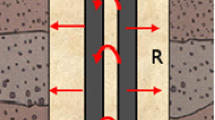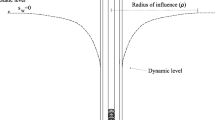Abstract
Measurement of the hydraulic coefficients of soil or rock is carried out with the aid of double packer conductivity meters in wells or boreholes. The evaluation of tests is based on the theory of creeping flow through a porous medium. The theory leads to a non-steady cylindrically and axially symmetric heat conduction problem in an infinity domain outside a circular hole with mixed boundary conditions. With the aid of a simple but efficient approximation, which describes the singularity of the boundary value, two of the three integrations in the solution can be evaluated in closed form. The analysis shows that the problem can be reduced to a simple Volterra integral equation, which is easily solved with numerical means. The solution is characterized by one single parameter, namely the aspect ratio of the cylindrical inner cavity.
Similar content being viewed by others
References
Abramowitz, M. and Stegun, I.A., Handbook of Mathematical Functions. Dover, New York, 1970.
Barker, J.A., A generalized radial flow model for hydraulic tests in fracture rock. Water Resour. Res. 24 (1988) 1796–1804.
Cassiani, G., et al., Flowing partially penetrating well: Solution to a mixed-type boundary value problem. Adv. Water Res. 23 (1999) 59–68.
Doetsch, G., Anleitung zum praktischen Gebrauch der Laplace-Transformation. R. Oldenburg, München (1956).
Erlougher Jr, R.C., Advances in Well Test Analysis. New York, (1977).
Gradsteyn, I.S. and Ryzhik, I.M., Table of Integrals, Series and Sums. Academic Press, New York, (1980).
Hantush, M.S., Hydraulics of Wells. V.T. Chow (ed.), Academic Press, New York, 1964.
Hayashi, K., et al., A new method for determination of in situ hydraulic properties by pressure pulse test and applications to the Higashi geothermal field. J. Geophys. Res. 92 (1984) 9168–9174.
Ingersoll, A.C., et al., Theory of earth heat exchangers for heat pump. Heating, Piping & Air Conditioning (1950) 113–122.
Lugeon, M., Barrage et Geologie. F. Rouge et Compgnie, Lausanne, (1933).
Nicholson, J.W., A problem in the theory of heat conduction. Proc. Roy. Soc. A100 (1921) 226–240.
Petersen, T.E., Eliminating Gibb’s effect from variables separation solutions. SIAM Rev. 40(2) (1998) 324–326.
Rehbinder, G., A comparison of two equivalent solutions of the diffusion equation. Numerical Methods for Partial Differential Equations 15 (1999) 657–671.
Rehbinder, G., The double packer permeameter with long packers. An Approximate solution. Appl. Sci. Res. 56 (1996) 281–297.
Theis, C.V., Relations between the lowering of the piezometric surface and the rate and duration of discharge of a well using ground-water storage. Trans. Am Geophys. Union. (1935) 519–527.
Author information
Authors and Affiliations
Corresponding author
Rights and permissions
About this article
Cite this article
Rehbinder, G. Relation Between Non-Steady Supply Pressure and Flux for a Double Packer Conductivity Meter: An Approximate Analytical Solution. Flow Turbulence Combust 74, 1–20 (2005). https://doi.org/10.1007/s10494-005-2757-y
Received:
Accepted:
Issue Date:
DOI: https://doi.org/10.1007/s10494-005-2757-y




